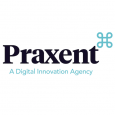Don't rewrite your software application, modernize it.
Digital experience design and development for Financial Services brands with outdated technology.
INDUSTRIES: Insurance, Lending, Wealth Management, Real Estate, Banking
At Praxent we know you want to be a savvy, pragmatic innovation leader. In order to do that, you need a modern, intuitive digital experience to serve customers. The problem is your current applications are too complex to easily rebuild and are becoming more outdated by the day. That has left you feeling overwhelmed by the complexity of your legacy systems and unable to align stakeholders around the need for change.
We believe there ought to be a way to improve your digital customer experience without betting the farm on an all-or-nothing rewrite. We understand your software applications aren’t getting any younger, which is why we have assembled a fast-moving team of 70+ software designers and engineers that have delivered over 300 software transformations over the past 20 years for clients such as Keller Williams, Texas Mutual Insurance, Dimensional Fund Advisors, NRG, The City of Houston, Austin Capital Bank, Norcal Mutual and more.
Here’s how we do it:
Assess. We assess your situation and present a proposal with three investment options.
Design & Build. We design and build a modern user experience, supported by a robust full-stack architecture.
Launch. You launch a modern, intuitive software application that that lives up to the promise of your brand.
So, schedule a call today. So you can stop losing customers to born-digital competitors and instead enjoy the feeling of accomplishment as you compete with confidence.
Focus Areas
Service Focus
- Software Development
- App Designing (UI/UX)
- Web Designing (UI/UX)
- Mobile App Development
- Web Development
Client Focus
- Medium Business
- Large Business
- Small Business
Industry Focus
- Real Estate
- Insurance
- Financial & Payments
Praxent Executive Interview

I founded the company in 2000, working initially as a lead developer and designer on our first projects. While my background is in IT, today my focus is on leadership development and growth strategy.
Since I started Praxent 18 years ago, creating a positive work environment has been extremely important to me, personally. The fact that 70% of the American workforce reports feeling disengaged at work is both discouraging and motivating. One of the things that motivate me most is working alongside my senior leadership team to reverse this trend by creating an empowering, freedom-centered work culture for our team and, in doing so, inspiring others to follow along.
Several years after starting the company, I graduated from the University of Texas with a degree in management information systems and economics. By this time, Praxent (then Astonish Designs) had established a solid client base and was continuing to grow.
The following years saw the company mature in its identity and unique value proposition. While a lot has changed since we started in 2000, we have worked hard to maintain our commitment to our clients, our ability to adapt to change and a desire to improve continuously.
Our teams consist of individuals based both in Austin, where we are based, and beyond, including throughout the US and Latin America. We have always embraced remote collaboration and enjoy the talent flexibility that our distributed teaming affords us.
We are slow to hire, so the teams we have today are the result of years of careful vetting and selection. Our interview process is so selective that we routinely have to evaluate 100 or more candidates before making a single hire. It’s been a discovery process of learning what individual team member characteristics and professional backgrounds deliver the most value to our clients.
While we invest significantly more in our interviewing practices than our competition, we feel strongly that this is the right approach. Through the process, we find principled professionals with the right combination of expertise and service attitude. We’ve created an atmosphere that keeps them motivated and engaged. As a result, we can confidently say that every Praxenter is intellectually humble, driven to make an impact and motivated to serve.
Having delivered over 300 successful projects, we have become very good at building effective teams that consistently overcome even the most complex obstacles.
2. Our fully-integrated services take clients from idea to implementation
Releasing a new digital product requires the detailed coordination of many work streams. It also requires expert thought applied to strategy, UX, UI design, technical architecture, software engineering, testing, and infrastructure.
Best-in-class digital products are designed and built by dynamic, multi-disciplinary teams. Asking a concrete or linear thinker to participate in the conceptual and strategic phases of a new product development effort can lead to misunderstandings. Meanwhile, relying on a high-level conceptual strategist to be responsible for on-time, on-budget delivery by date-certain can be disastrous.
For our clients, building an in-house team that possesses all of these skills is cost prohibitive and extremely time -consuming. Retaining them over the long-run requires an investment of time and money into management, professional development, and career planning.
Because we have all of these skill sets, areas of expertise and styles under one roof, we can staff them fractionally to fill the gap as client needs change. And finally, we don’t just partner on the conceptual and strategic work of creating products (professional research, testing, and user experience). We’ll also be here to build it when the time is right.
3. Repeatable delivery processes designed to reduce risk
64% of the software that is created today is waste. This shows up in features that are built but, sadly, never used. In addition, 68% of projects go significantly over budget or never finish.
While the details behind this research are complex, the solution is relatively simple – better business analysis. Projects that begin with thorough requirements validation, mature technical design and cross-team planning perform significantly better.
In our 18 years, we have delivered over 300 projects for clients ranging in size from startups to Fortune 50’s. To deliver these projects, we have built hundreds of teams consisting of different combinations of developers, designers, testers and business analysts. We have learned from experience how to set up a complex project for success. Our organizational design, management, and hiring practices reflect this learning.
Hundreds of our clients are repeat clients who have come back to us for:
● Ongoing maintenance on the projects we completed
● New additions to a product suite
● Significant new features for products we created for them in the past
Clients need to work through an initial discovery phase either with us or before they come to us. This phase includes:
● User research to validate the effectiveness and likely traction of the envisioned solution. This enables us to qualify feature ideas with real user input before we include them in the product roadmap.
● Clear value propositions and a market strategy for the product. For a product to be great at something, difficult decisions must be made to determine where to underperform relative to the competition. In most cases, we help clients develop or refine their strategy to prepare for the next phase.
● A product roadmap that lays out the features and capabilities of the system organized by functional area and release timeframe.
Using this information, we work together with clients to prioritize features and clearly define a minimum viable product. This step answers the question: what features do we need, at the minimum, to make this product successful with users?
We create a working prototype with those features and then do lean testing to validate the concept and refine as needed.
After this preliminary work, we can give an accurate cost and timeline estimate. Without research, prototyping, and testing, the project would move forward based purely on the assumption. Starting development without first testing assumptions puts the plan at high risk of going over budget and overdue should we discover problems with the initial concept.
Instead, we mitigate risk by validating the concept ahead of time. This weeds out incorrect assumptions before making a significant investment in development. From a place of confidence, we provide clients with accurate estimates and move forward into the roadmapping stage.
● Client leadership. Does the client intend to build their own team or will we be maintaining the product for them long-term? If they intend to build their own team in the long run, we prioritize frameworks that they have experience working with.
● Use cases. What are the strengths or most common uses of a particular framework and how do those align with the requirements of this project?
● Bleeding edge. What sort of appetite do we feel is prudent for adopting a bleeding edge framework versus taking a more conservative approach? In the vast majority of cases, more mature frameworks have more tools and have been more thoroughly vetted; therefore, selecting them can make the team more productive.
● Future proof. What is the likely future of a particular open-source framework? Is there strong community or commercial support that favors one framework over another?
● Hiring. Do we need to focus on tools that have a strong developer following to support future team building and hiring?
● Retention. How likely is it that developers will remain optimistic about a chosen technology over the long run? If the open source community abandons a framework, developers tend to worry about pursuing a career dead-end by continuing on with that technology.
In addition to React, Python and .NET, we have worked extensively in Angular, Ember, Java, PHP and multiple CMS flavors. An exhaustive list of our current skill set is listed, below.
FRONTEND
React
Angular
Ember
HTML5/SCSS
AMP
Electron CMS
WordPress
Drupal
SiteCore
DATABASE
PostgreSQL
MySQL
MSSQL
MongoDB
DevOps
Docker
Wercker
Jenkins
Kubernetes
Ansible
Octopus Deploy
Github
Rancher
Gulp/Babel
PhantomJS
BACKEND
C# on .NET
Python on Django
PHP on Symfony/Silex/Laravel
NodeJS on Express/Sails
Java
SysOps
Amazon Web Services
Google Cloud
Azure
Heroku
Linux: CentOS/Debian
Apache
Nginx
IIS
Solr
Reddis
MOBILE
iOS
Objective-C/Swift
Android
Java
React-Native
Xamarin
PWA
AppCenter
Using our custom-built ROM Estimator, we analyze technical requirements and compare the proposed product with comparable systems from our 18 years of experience. This exercise allows us to generate multiple staffing and project scenarios for the proposed product. We incorporate these steps into our ROM estimations:
• We identify separate work streams for the project based on logical and functional differences among the major activities.
• We perform a team-based estimating exercise to ensure the process isn’t overly biased by a single estimator.
• Depending on a variety of factors, we apply contingency buffers that account for unknowns.
There are two points worth emphasizing:
Estimating is not a one-time event.
We estimate projects repeatedly throughout their lifecycle. While estimating is not in itself complex, it can be counter-intuitive. Using the wrong estimating method at the wrong phase of the project can lead to massive cost overruns.
Change happens in every project.
For our clients and us, “done” is always a moving target. That’s because we build digital assets for changing environments with new competitive entrants and shifting market dynamics.
“How” is also a moving target because software teams aren’t static and the available tools are constantly evolving.
In this business, change is neither unacceptable nor an unlikely external event. It’s an expected rhythm often precipitated by the client’s business or user needs.
For these reasons, we have found that project pricing and planning methods must be designed to respond to change.
● The conversion rate for traffic from Goodfirms.co is over 11% (site average is about 1.2%).
● Goodfirms traffic makes up about 0.5% of our traffic and over 4% of our goal conversions.
● Traffic from review sites accounts for about 13% of site traffic and 19% of goal conversions.
Praxent Clients & Portfolios





Praxent Reviews
- All Services
- Software Development
- Web Development
- Relevance
- Most Recent
- Rating: high to low
- Rating: low to high

Scalable Web Architecture For Certification Management
Review Summary
The system was made scalable, capable of registering 3000-4000 students at the same time. Also, it worked anywhere, in a gym or field and efficiently on any computer or mobile device. The user experience they created is easy to use and intuitive, to minimize the time needed for training.
The product they developed was scaled to previous methods, so the volunteers can directly check birth certificates of the children, complete the profiles and print their ID Cards reliably and efficiently. The system also sends guardians a waiver, which they can sign electronically and then the kids can compete safely within their age bracket. The process has been so smooth.
Pros of the application: It saved TYFA thousands of dollars annually by eliminating the need for professional photography with the integration of hardware cameras. Cuts volunteer training to a minimum with a simple, user-friendly interface. Reduces processing time per player by nearly 50%. Enables coaches to access up-to-date roster data and quickly verify player eligibility, replacing a cumbersome paper-based method that was often outdated.
What was the project name that you have worked with Praxent?
Scalable Web Architecture For Certification Management
What service was provided as part of the project?
Mobile App Development, Web Development
What is it about the company that you appreciate the most?
My experience with them has been astonishing and awesome. With Praxent, it’s all about getting the product the way we wanted it to match our flow, making everything very easy for us. The system has actually freed up a lot of my time to do other things. We’re able to do everything – take pictures, verify data anywhere and on any device. The result of the application we saw was safer and easier to get these athletes on the field

Our journey was from a product company to a software company
Review Summary
The platform was divided into three components:
Dashboard: Cloud-based experience manager in a gallery can be called as the Dashboard. From the time user interacts with the apps when they receive the photo online; we wanted that to be the white label and user customizable from the central location.
The second component is an application which can on Photobooth’s iPad
The third component is a Daemon application that runs inside the booth itself. This daemon is the brain of the system connecting all the components together and enabling real-time viewing and analytics of all the data collected during the experience.
Being able to streamline all the information into a platform that the agency can access is an extremely valuable service which Praxent provided us. The client can see the photo uploaded, see them engaged, etc. The clients can also access and browse their other pictures from the Dashboard. It allows them to view the other pictures, save them in their own gallery and get engaged with all social media platform. After the success of the Photomadic platform, we started working with lots of software companies with a contract of 2-3 years of projects, as we are having the software that they need. They can manage and experience all the things at once rather than one-half solution whenever they needed them.
What service was provided as part of the project?
Software Development, App Designing (UI/UX)
What is it about the company that you appreciate the most?
They were asking real questions and more caring about our business. Looking at our problems and try to solve them in a quick and easy manner. We were together inventing. They look after the technology and future, hence with a technology development company, they were also a strategic company.

Best services and solutions
Review Summary
What service was provided as part of the project?
Software Development
What is it about the company that you appreciate the most?
Talking through their team about the whole concept was beneficial and kind of step out from spreadsheet level and think at a bigger level. In the 1st year, when launched the Dashboard online, we had a 60% increase in our subscription model. It helped to draw people to us, who haven’t heard of us before that is expanded client network. Also, there was lead by a 42% increase in total revenue. Every time they look at their client, they look forward to fundamentally change their game in the matter of business or even in their industry by giving them the best solutions and services.

Incredible Company to work with
Review Summary
What service was provided as part of the project?
Web Development, Software Development, Web Designing (UI/UX)
What is it about the company that you appreciate the most?
The work software engineers have done for us is take out a vision and create reality, which is not only helping the students across the country but eventually the globe. We are one step closer to the reality that how to make fitter and healthier world for our kids.
What was it about the company that you didn't like which they should do better?
N/A

Success of Workflow Management Software
Review Summary
What service was provided as part of the project?
Web Development, Software Development, Web Designing (UI/UX)
What is it about the company that you appreciate the most?
Working with them has been a great experience. Their team has been reliable, providing feedback and also expanding my vision in helping me what I wanted to make and expanding it even further with the best option for our future upgrowing and profit.
What was it about the company that you didn't like which they should do better?
Nothing much.









